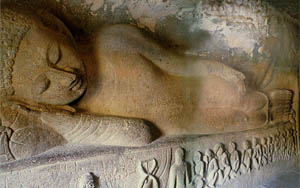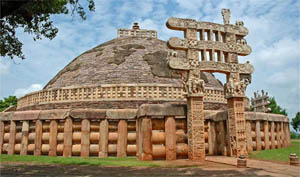| Buddhist Sculptures |
 |
The next golden chapter of Indian sculpture opens in the 3rd century BC, when the Mauryan Emperor Ashoka adopted Buddhism and set out on a mission to spread the teachings of the faith as far and wide as possible. He had 85,000 stupas or dome-shaped monuments constructed with the teachings of Buddhism engraved on rocks and pillars. These inscriptions which served as edicts can be seen in Buddhist monuments in Gujarat, Bihar, Madhya Pradesh and Tamil Nadu. |
| The famous Ashoka Pillar at Sarnath in Madhya Pradesh gleams in polished sandstone representing the hieratic art under the Mauryan Empire. The lion capital of the pillar is now the official emblem of the Indian Republic and the sacred wheel of law or the dharmachakra is symbolic of the first sermon that Buddha delivered at Sarnath. |
 |
The Great Stupa at Sanchi is perhaps the finest surviving relic of the Mauryan Empire and is a renowned Buddhist monument. Its finely carved gateways depict Buddhist legends and lifestyles of two thousand years ago. The foundation of the Stupa was laid by Ashoka and he set up monasteries here as a retreat for the Buddhist monks. The Great Stupa is fifty-four feet high and is surrounded by a stone railing and four elaborately carved gateways on each side. |
The gateway reliefs depict tales of Buddha's incarnations, his life as a prince, his moment of enlightenment, his sermons and his worshippers. This site at Sanchi also includes remains of smaller stupas, pillars and monasteries.
In the 1st century AD, the position changed somewhat radically in art and sculpture. The human figure replaced the symbolic representation of Buddha and his teachings. Though Buddha opposed the idea of idol worship, his cult image was established and became essential for acts of worship. The Mathura and the Gandhara schools of sculpture imparted human form to Buddha's image. To emphasise his divinity, this human form was depicted with features like a halo around the head, the dharmachakra engraved upon his palms and soles of his feet, and the lion throne representing his royal ancestry. These early stone images of Buddha are awe-inspiring in terms of size and magnificence.
The Buddha statues of the 5th century exhibit a unique sensibility with human figures that are meditative and serene, a body that is subtly modelled and a face that glows with enlightenment. Here, the ultimate definition of the divine is indicated in the soft folds of the dress, the exquisite curvature of the hands and the half-closed eyes of the Buddha.
|
|
| Featured Paintings Gallery - Orissa Tribal |
|
|
|
